
Bright Ideas: How Electricians Transform Homes with Lighting Design?
Lighting design plays a crucial role in enhancing the ambiance, functionality, and aesthetics of a home. Electricians, with their expertise in electrical systems and fixtures, are instrumental in transforming living spaces through creative lighting solutions. In this article, we’ll explore the art and science of lighting design and how electricians use their skills to illuminate homes with brilliance and innovation.
The Importance of Lighting Design
Lighting design is indeed a multifaceted discipline that goes beyond mere illumination, encompassing various elements to create immersive and functional living environments. Let’s delve deeper into each aspect:
1. Mood Enhancement
Lighting sets the tone and atmosphere of a space, profoundly impacting mood and emotions. By adjusting the intensity, color temperature, and distribution of light, designers can evoke specific feelings and create tailored experiences. If you’re looking to enhance your lighting set up by an electrician in Sherman Oaks, consider consulting an electrician specializing in lighting design for expert guidance and installation services.
2. Visual Comfort
Properly designed lighting minimizes discomfort by mitigating glare, shadows, and contrast. Harsh lighting can cause eye strain and discomfort, whereas well-distributed, diffused lighting creates a visually pleasing environment. Lighting designers carefully select fixtures and adjust their placement to optimize visibility and reduce visual fatigue, ensuring that occupants feel comfortable and at ease in their surroundings.
3. Functionality
Lighting design enhances the functionality of each space by providing illumination tailored to specific activities and tasks. Task lighting, such as under-cabinet lights in the kitchen or reading lamps in the bedroom, illuminates specific areas for optimal performance. Additionally, accent lighting draws attention to architectural features, artwork, or focal points, adding depth and visual interest to the space while serving a functional purpose.
4. Aesthetic Appeal
Lighting is a powerful tool for enhancing the aesthetics of a room, highlighting architectural features, accentuating textures, and creating focal points. By strategically layering different types of lighting—ambient, task, and accent—designers sculpt the visual landscape of a space, transforming it from ordinary to extraordinary. Thoughtfully designed lighting enhances the overall ambiance and elevates the visual appeal of the environment.

5. Energy Efficiency
Advancements in lighting technology, such as LED bulbs and smart lighting controls, enable designers to achieve both aesthetic excellence and energy efficiency. LED lights consume significantly less energy than traditional incandescent bulbs and have a longer lifespan, reducing maintenance costs and environmental impact. Smart lighting systems allow for precise control over brightness, color, and scheduling, optimizing energy usage while enhancing user convenience.
6. Flexibility and Adaptability
Lighting design should be flexible and adaptable to accommodate changing needs and preferences. Dimmers, programmable lighting systems, and adjustable fixtures enable residents to customize their lighting environment according to different activities, times of day, or seasons. This adaptability ensures that the lighting design remains relevant and functional over time, reflecting the evolving needs and lifestyles of occupants.
The Role of Electricians in Lighting Design
Electricians are the backbone of lighting design projects, bringing technical prowess and collaborative spirit to every aspect of the process. Here’s a closer look at each facet of their indispensable role:
1. Technical Expertise
Electricians are masters of their craft, possessing an in-depth understanding of electrical systems and fixtures. They navigate the complexities of wiring, voltage requirements, and safety regulations with ease, ensuring that lighting installations not only meet aesthetic objectives but also adhere to strict building codes and safety standards. This expertise allows them to select the right fixtures, determine optimal placement, and execute installations flawlessly.
2. Installation and Implementation
With hands-on expertise, electricians are responsible for the practical execution of lighting designs. They handle everything from the installation of simple ceiling lights to the mounting of intricate chandeliers, ensuring that fixtures are securely wired and safely mounted. Additionally, they skillfully install switches, dimmers, and control devices, empowering users with convenient access to customize their lighting environments.
3. Problem-solving
Lighting design projects often present challenges that demand innovative solutions. Electricians excel in troubleshooting electrical issues, whether it’s untangling wiring complexities, resolving compatibility conflicts with existing infrastructure, or diagnosing and rectifying malfunctioning fixtures. Their adept problem-solving skills ensure the seamless operation of lighting systems, even in the face of unexpected hurdles.
4. Collaboration with Design Professionals
Electricians are integral members of interdisciplinary teams, collaborating closely with homeowners, interior designers, and architects. During the design phase, they actively engage in discussions to grasp the design vision and translate it into practical lighting solutions. By considering factors such as aesthetics, functionality, and energy efficiency, electricians seamlessly integrate lighting into the overall design concept, enriching spaces with both beauty and functionality.

5. Communication and Coordination
Effective communication is paramount in lighting design projects, and electricians excel in fostering transparent dialogue with all stakeholders. They liaise with design professionals and clients to align on project objectives, timelines, and budget constraints, offering valuable insights and recommendations grounded in technical expertise.
6. Continued Maintenance and Support
Beyond installation, electricians provide ongoing maintenance and support to preserve the longevity and performance of lighting systems. Conducting routine inspections, replacing worn-out components, and promptly addressing any issues that arise, they safeguard investments in lighting infrastructure. Their commitment to continued support ensures that lighting systems remain in optimal condition, enhancing the comfort and functionality of spaces for years to come.
Creative Lighting Solutions
Creative lighting solutions are essential for enhancing the beauty and functionality of homes, and electricians play a key role in implementing these techniques. Here’s a deeper exploration of some creative lighting techniques employed by electricians:
Layered Lighting
- Utilizing a combination of ambient, task, and accent lighting fixtures.
- Provides both functional illumination and ambiance.
- Allows for flexibility in adjusting lighting levels according to the time of day and activities.
- Achieves a harmonious balance of light throughout the room.
Dimmer Controls
- Installing dimmer switches for adjustable brightness.
- Enhances ambiance and mood.
- Conserves energy and extends the lifespan of light bulbs.
- Seamlessly integrated into lighting systems for user convenience.
Highlighting Architectural Features
- Employing directional lighting techniques.
- Accentuating architectural elements such as artwork, sculptures, or textured walls.
- Strategically placing spotlights or track lighting fixtures to draw attention.
- Adds depth and dimension to the room while showcasing unique design elements.
Outdoor Lighting
- Designing and installing outdoor lighting solutions.
- Enhancing curb appeal and increasing security.
- Includes pathway lighting, landscape lighting, deck lighting, and security lighting.
- Creates a welcoming ambiance for outdoor gatherings while improving safety for homeowners and guests.
Smart Lighting Systems
- Installing advanced control and automation features.
- Allows remote control of lights via smartphone apps or voice commands.
- Offers convenience and energy efficiency.
- Enables customizable lighting scenes for different activities and occasions, enhancing overall comfort and functionality of the home.

Conclusion
In conclusion, electricians play a vital role in transforming homes with creative lighting design solutions. From installing a variety of lighting fixtures to implementing innovative techniques such as layered lighting, dimmer controls, and highlighting architectural features, electricians bring brightness and beauty to every room in the house.
By collaborating with homeowners, interior designers, and architects, electricians create personalized lighting designs that enhance the ambiance, functionality, and aesthetics of living spaces. With their expertise and creativity, electricians illuminate homes with brilliance and innovation, turning bright ideas into reality.
